
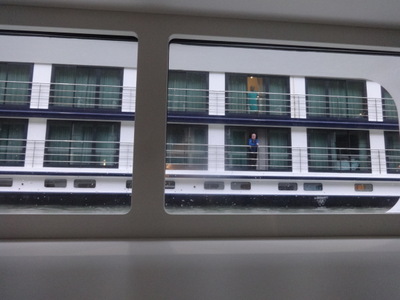 A quiet day on the Vidar today. Here's the view from my window as we enter a lock. As you can see from the distance to the far wall, it's a pretty big one.
A quiet day on the Vidar today. Here's the view from my window as we enter a lock. As you can see from the distance to the far wall, it's a pretty big one.Friday, 30 September, Vienna, Austria (with Mozart and Strauss)
Written 17 December 2022

 A quiet day on the Vidar today. Here's the view from my window as we enter a lock. As you can see from the distance to the far wall, it's a pretty big one.
A quiet day on the Vidar today. Here's the view from my window as we enter a lock. As you can see from the distance to the far wall, it's a pretty big one.
At the right is the same view a few minutes later, when a second cruise ship has slid in next to us. At this point, locks were still a novelty, as we'd passed through very few.
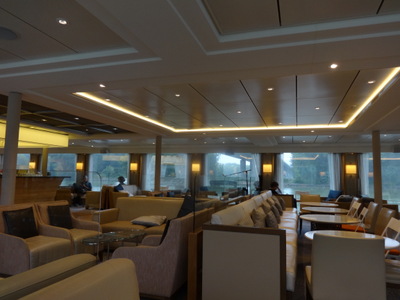
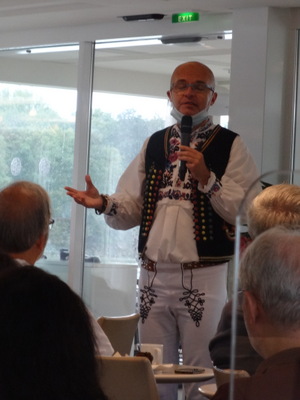 The day was dim and drizzly—another example of our exceptional luck with the weather on this cruise, a perfect day to lounge on board and enjoy the afternoon's "Austrian tea."
The day was dim and drizzly—another example of our exceptional luck with the weather on this cruise, a perfect day to lounge on board and enjoy the afternoon's "Austrian tea."
But before that, our Tour Director Marek was slated to talk about growing up in eastern Europe during communist times. At the left is my view of the lounge as we passed under a pretty large bridge, and at the right is Marek, decked out in his native Slovakian costume. The event was well timed, as we cruised through Slovakia during his talk, though we didn't stop.
Marek's mother gave him the costume for his 16th birthday, and he is proud to show that it still fits (although he admits that it's made of stretch fabric with an elastic waistband). At 16, he thought it was silly, but his mother assured him that he would be glad of it later. And in fact the idea grew on him. He got interested in the many variations in the elaborately embroidered, smocked, and decorated traditional costumes of the slavic nations and began collecting dolls dressed in miniature versions of them. The miniatures are much more expensive than the full-size versions—if you think smocking is tiny and fussy in real life, try doing it in miniature! You can see a portion of his collection on the Facebook page for "Marekove bábiky / Marek's dolls." He plans to open an actual museum soon.
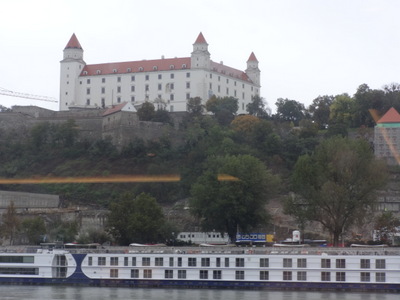
 At the left here is Bratislava castle, with a cruise ship called La Douce France, moored below it.
Marek described its four towers as making it look like an upside down table. He joked that we should watch for his parents, waving from the upstairs windows, but in reality they live in his home village, a ways inland from the city (Marek says it's small but cute). The castle now includes a museum, a wedding venue, and other amenities. Until recently, it was brown, but they've now painted it white. The gothic St. Martin's Cathedral is apparently right next to it but does not show in my photo. Hungarian kings and Maria Theresa were crowned there.
At the left here is Bratislava castle, with a cruise ship called La Douce France, moored below it.
Marek described its four towers as making it look like an upside down table. He joked that we should watch for his parents, waving from the upstairs windows, but in reality they live in his home village, a ways inland from the city (Marek says it's small but cute). The castle now includes a museum, a wedding venue, and other amenities. Until recently, it was brown, but they've now painted it white. The gothic St. Martin's Cathedral is apparently right next to it but does not show in my photo. Hungarian kings and Maria Theresa were crowned there.
Slovakia is the size of Massachusetts. Half a million people live in the capital, Bratislava, and 7.5 million in the country. Bratislava was the capital of the Hungarian empire for 200 years. Nowadays, the shopping mall has the largest glass roof in central europe, and what Marek called the Rising Bridge has a flying-saucer-shaped restaurant mounted on its single, asymmetrical pylon. The restaurant doesn't turn, but Marek says your head does when you read the prices on the menu. Unfortunately, the photo at the right is the best view I could get of it, through a rain-spattered window. When Marek called it the "rising" bridge, I assumed he meant it was a lift-bridge that could be raised to let ships underneath, but I learned later that it's a fixed suspension bridge (suspended from a single pylon on one bank). It was named for the (up)rising in 1956.
Slovakia was part of the Moravian Empire, but when that broke up in the 1100's, Slovakia joined Hungary. The Hungarian Empire became Austro-Hungarian empire. Again according to Marek, the Austro-Hungarian empress liked Hungary and gave them more privileges. (Was that Empress Elizabeth, the "Sisi" mentioned earlier in this diary?)
In 1918, Slovakia broke up with Hungary and joined the Czechs to form Czechoslovakia. From 1939 to 1942, Czechoslovakia was a satellite of Adolf Hitler. At 10 pm Nazis would come to the door and ask to be put up for the night, and you'd have to agree.
After that, Czechoslovakia stopped at socialism and never got to full communism; some people were more equal than others. You could keep your house but all your land became property of the state. Everybody had to work. Mothers wre not allowed to stay at home and had to have outside jobs. To keep unemployment at zero, the country had to raise employment artificially by producing all sorts of useless items to export. The government chose where you could work, once you passed the entrance exams or studied. Once you were assigned a job, you were there for life. You were assigned an apartment when you got married, but you couldn't leave any inheritance for your kids. There was no reward for better performance, so workers developed the attitude, "You pretend to pay us, we pretend to work."
The practice of religion was allowed but was strongly discouraged among the highly educated and those in the military. Only the poor and ignorant could go to church because they weren't plotting revolutions. People stood at the door to watch who came out of church. Families took to going to little country churches way out of town for baptisms and confirmations, so nobody would know.
It wasn't safe to talk to your classmates or friends. The apartments all had thin walls, so that you could hear your neighbors and turn them in. If you didn't join the party, you couldn't be a teacher; you had to work in factories.
In elementary school you became a "spark." A few years later, you became "scout" and got a red scarf. At 14 you could become a "pioneer." As a young adult, with a two-year degree, you could become a union member and wear a red tie.
Marek grew up under this system but never became a union member because he was 13 when communism collapsed. Czechoslovakia underwent a bloodless revolution, and Václav Havel was elected president. The factories producing useless products closed, and people lost their jobs. The country went from zero to 35% unemployment overnight. In Czechoslovakia, they had kept the records, so they could return property to the children or grandchildren of those from whom it was taken under communism. (In Romania, Ceaucescu destroyed the records, so restitution was chaos.) Marek learned that his education had been limited—when he came to work for Viking, he had never heard of Ann Frank.
In 1993, Slovakia separated from what Marek called their "Czech brothers." He said nobody knows why, because the languages are extremely similar, and they like each other; the cultures are similar. Go figure.
Today, Marek is very proud of his country. He says it has 50 different castles just in the western part, and it's better and cheaper than the Alps for hiking. In fact, after Bratislava, we were back to natural river banks. Slovakia is 80% Roman Catholic, but Bratislava has a lovely Jewish community.
On Easter Monday, boys take willow whips to visit and slap girls. It's supposed to give them (the girls, presumably) a good attitude for the rest of the year, and the girls like it. In the 19th century, at age 15, if a girl didn't already have an Easter visitor, he neighbors would worry she would be an old maid. Nowadays, not so much. The custom is left over from agrarian times and is not really a religious tradition. Girls also have to be doused with cold water, to be healthy all year round. Marek tried this with his mom once, and got smacked.
Slovaks eat carp for Christmas, baking it 3 hours on a brick with seasonings, and of course they share the usual joke about then throwing away the carp and eating the brick. As we passed Castle Devin, which Marek pointed out on the right, we left Slovakia and entered Austria.
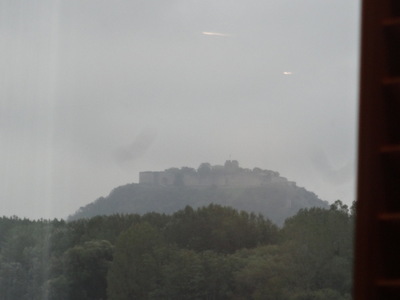
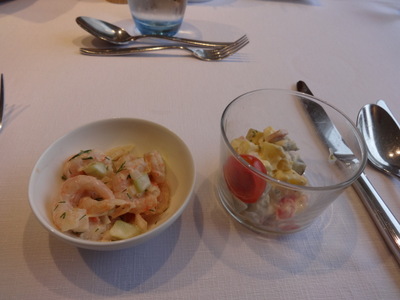 I always have trouble matching my photos to my recorded notes, but I'm pretty sure this is Castle Devin, seen through the fog and drizzle as we left Slovakia.
I always have trouble matching my photos to my recorded notes, but I'm pretty sure this is Castle Devin, seen through the fog and drizzle as we left Slovakia.
Meanwhile, we had very good "fine print" appetizers: shrimp and potato salads.
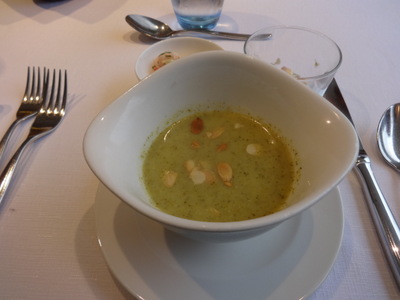
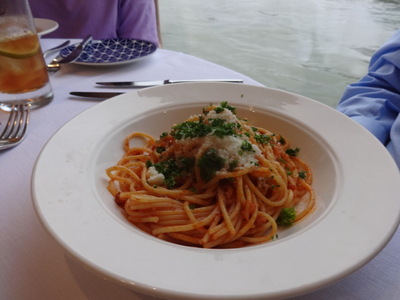 The regular appetizer was cream of broccoli soup, sprinkled with sliced almonds. It was good, but David and I agreed that mine is better.
The regular appetizer was cream of broccoli soup, sprinkled with sliced almonds. It was good, but David and I agreed that mine is better.
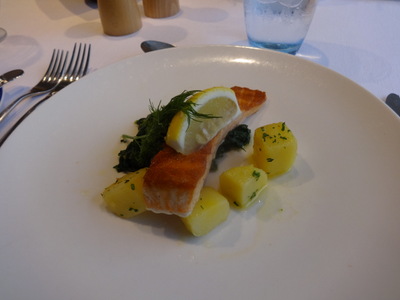
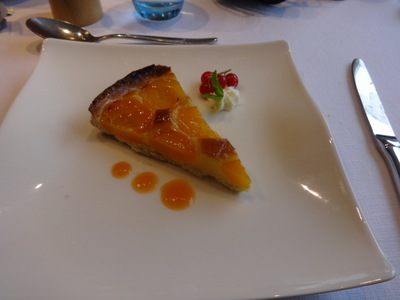 I chose grilled salmon with spinach and potatoes. Viking goes through a lot of salmon on every cruise, both fresh and smoked, and they do a very good job with it.
I chose grilled salmon with spinach and potatoes. Viking goes through a lot of salmon on every cruise, both fresh and smoked, and they do a very good job with it.
We both passed up the sorbet of port-marinated melon (David because of the melon and me because of the port) and enjoyed the apricot tart.
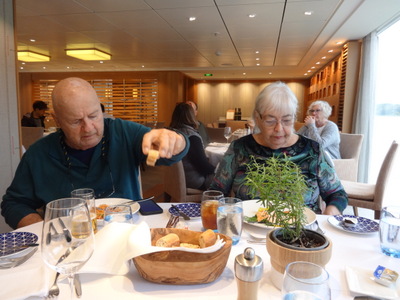
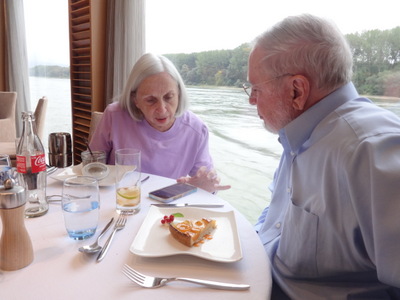 Here, at the left, are Ron and Sallie (with the same two choices we made).
Here, at the left, are Ron and Sallie (with the same two choices we made).
At the right, Jan and David conferring over dessert. Jan's little canning jar is filled with chocolate mousse from the "always available" menu.
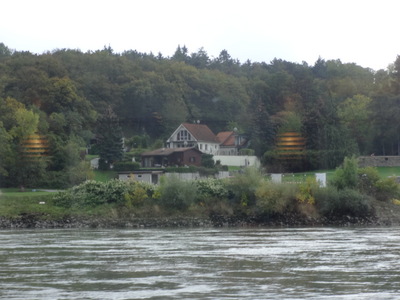
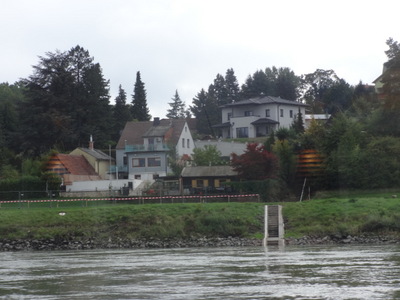 Here, left and right, are a couple of riverside houses we passed, in Austria but before we reached Vienna. Farther along, during "Austrian teatime," we passed a number of smaller ones that I didn't get good photos of. They were, basically, tarpaper shacks, of just one or two rooms, their shabby appearance belied by the solar panels on most of their roofs. Marek said they weren't intended for occupancy beyond maybe a weekend stay. Many had square fishing nets out front, suspended on poles to dry, so I assume they were weekend fishing retreats.
Here, left and right, are a couple of riverside houses we passed, in Austria but before we reached Vienna. Farther along, during "Austrian teatime," we passed a number of smaller ones that I didn't get good photos of. They were, basically, tarpaper shacks, of just one or two rooms, their shabby appearance belied by the solar panels on most of their roofs. Marek said they weren't intended for occupancy beyond maybe a weekend stay. Many had square fishing nets out front, suspended on poles to dry, so I assume they were weekend fishing retreats.
We missed "Serbian teatime" while we were touring Lepinski Vir on Saturday, so this was our first teatime of the cruise.
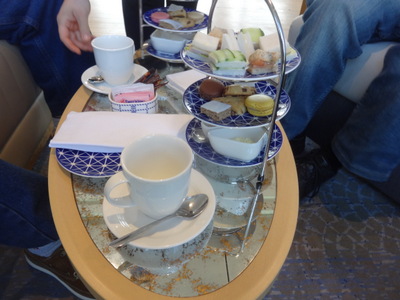
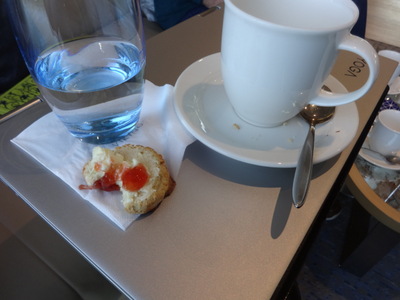 First, servers came around the lounge taking tea orders. From the three or four available, I chose mint. Each person's tea was made in a tall glass infuser that resembled (and may actually have been) a French press coffee pot and held about a cup and a half of tea. In the little buffet area between the lounge and the Aquavit Terrace (conveniently located at the top of the stairs up from the kitchen), the pots of tea were prepared and brought to our tables in the lounge. Unfortunately, the staff had vastly underestimated teatime participation—they quickly ran out of infusers, with the result that the moment you poured the last of your tea, someone snatched the infuser away so it could be washed and reused. No hope of getting a second pot.
First, servers came around the lounge taking tea orders. From the three or four available, I chose mint. Each person's tea was made in a tall glass infuser that resembled (and may actually have been) a French press coffee pot and held about a cup and a half of tea. In the little buffet area between the lounge and the Aquavit Terrace (conveniently located at the top of the stairs up from the kitchen), the pots of tea were prepared and brought to our tables in the lounge. Unfortunately, the staff had vastly underestimated teatime participation—they quickly ran out of infusers, with the result that the moment you poured the last of your tea, someone snatched the infuser away so it could be washed and reused. No hope of getting a second pot.
The photo at the left shows the three-tiered trays of nibbles they brought us—one for every two people. They bore, per person, one each cucumber, ham and cheese, curried cream cheese, and smoked salmon finger sandwiches; a square of walnut cake, two macarons sandwiched with jam, and a triangle of chocolate-chip brown-sugar shortbread; and, on the bottom tier, little triangular dishes of whipped (in lieu of clotted) cream and strawberry jam. The cream and jam were for what Viking calls "scones," though they more closely resemble southern U.S. beaten biscuits, served warm from the oven. They also vastly underestimated the number of scones they would need—our table got the last ones, so at least a third of the lounge never got any. That's half of one, adorned with cream and jam, in the right-hand photo. Notice that I was, very carefully, using my closed computer, on my little folding computer stand, as a tray table.
Quite a nice tea, really. I remember the shortbread, from a previous cruise, as being heavy and doughy, not quite done in the middle, but this chef did a better job of it—it was great!
And heaven forfend anyone should go hungry on a Viking cruise. The tea was at 3:30 pm, and was closely followed, at 4:45 pm, by hot passed hors d'oeuvres (e.g., slices of sausage roll and bbq meatballs on picks) and wine to celebrate Viking's 25th anniversary, which happened to fall that day. Then supper was served early, at 5:45 pm, to allow those of us who had chosen the evening's optional concert excursion to get there on time.
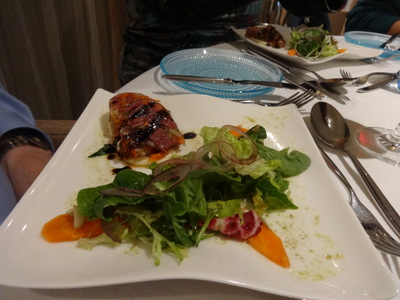
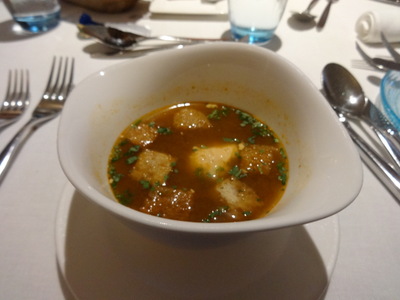 To tell the truth, I have no idea what that is in the left-hand photo! It doesn't seem to match the description of anything on the menu. Jan, David, Sallie, Ron—did you order that, and do you remember what it was?
To tell the truth, I have no idea what that is in the left-hand photo! It doesn't seem to match the description of anything on the menu. Jan, David, Sallie, Ron—did you order that, and do you remember what it was?
I went for the traditional fish soup with rouille sauce and croutons. Good, but I've had better in France.
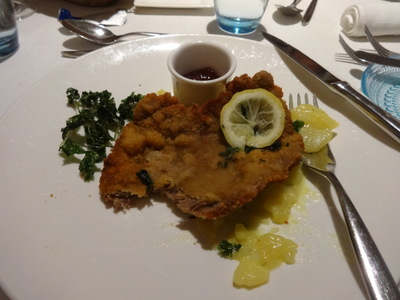
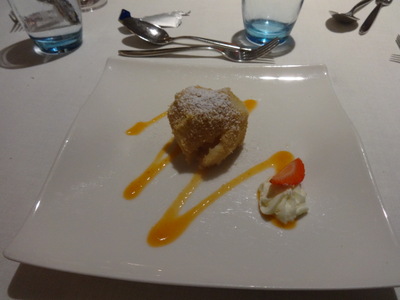 David ordered the Wiener schnitzel (we were in Vienna, right?), which came with German potato salad and fried parsley.
David ordered the Wiener schnitzel (we were in Vienna, right?), which came with German potato salad and fried parsley.
For desert, I ordered the apricot dumpling, which consisted of a whole fresh apricot, pit and all, wrapped in dumpling dough, deep fried like a donut, and dusted liberally with cinnamon sugar. Unfortunately, an unsweetened cooked apricot is really sour, and the cinnamon sugar wasn't enough to make up for that; the whole thing was too sour to finish.
We moored in Vienna during dinner. Ducks and swans were plentiful in the surrounding waters.
Then it was into the buses for the trip to our concert. Here's some of what we learned on the bus:
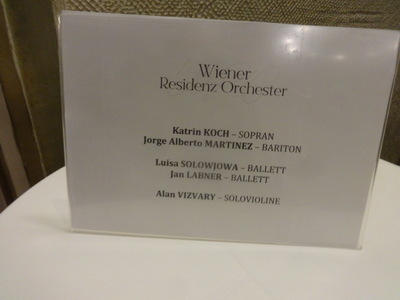
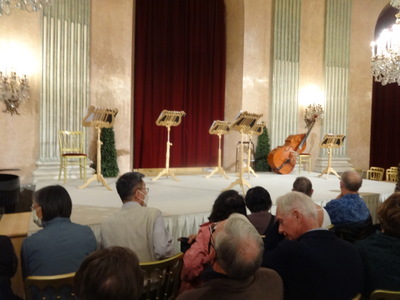 The venue for our concert was the Auersperg Palace. At the left is a photo of the list of some of the performers for the evening. The "Wiener Residenz Orchester," from which they were drawn, is a larger organization with a slick website, at https://www.wro.at/en/.
The venue for our concert was the Auersperg Palace. At the left is a photo of the list of some of the performers for the evening. The "Wiener Residenz Orchester," from which they were drawn, is a larger organization with a slick website, at https://www.wro.at/en/.
We got a piano, three violins, flute, cello, a string bass; a baritone and soprano; and a couple of dancers who did both ballet and ballroom. You can see the stage set-up in the photo at the right.
The first half was all Mozart, the second half all Strauss. Champagne was served in the lobby during intermission.
Now these folks do this show at least every day, if not more than once a day, for Viking alone, so if some of them seemed a little tired of the repertory, they were more than compensated for by the "solovioline," the first violinist, who was enthusiasm personified. He clearly loved every minute of it and the applause it brought. I can't claim to be a connaisseur, but if Mozart and Strauss can be played, sung, or danced to better, I can't tell the difference. I thought it was great!
The only untoward incident was that a fellow passenger twisted her knee on the stairs on the way out and had to be helped, sobbing, back onto the bus. Later in the evening, she finally took Marek up on his offer to take her to the emergency room, where she was diagnosed with a torn meniscus. Viking routinely keeps a wheelchair aboard, which they placed at her disposal, and within a few days they produced a walker from somewhere, and she graduated to that. She made a future appointment with her doctor at home and was able to finish the cruise.
Back on the bus, on the way back to the ship about 10 pm, we were passed on the street by a large herd of folks on roller blades, followed by a somewhat smaller herd on bicycles, just like the ones in Paris! Apparently late-night roller rallies have spread to capitals across Europe!
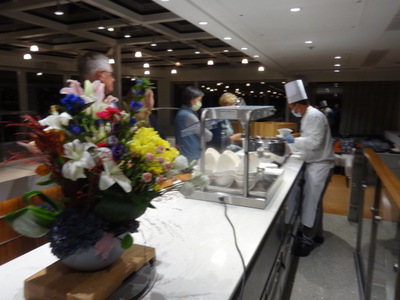 But the evening wasn't over yet. In case we hadn't gotten enough to eat, and because supper had been so early, we were invited, as we reboarded the ship, to the Aquavit buffet area again for goulash soup and bread! David looked at me like I was nuts, but of course I had to try it—we hadn't had goulash yet. I had half a bowl, and it was delicious!
But the evening wasn't over yet. In case we hadn't gotten enough to eat, and because supper had been so early, we were invited, as we reboarded the ship, to the Aquavit buffet area again for goulash soup and bread! David looked at me like I was nuts, but of course I had to try it—we hadn't had goulash yet. I had half a bowl, and it was delicious!